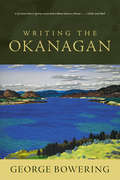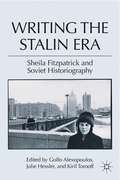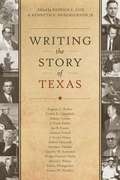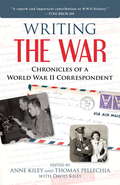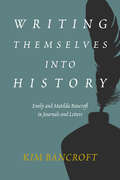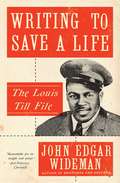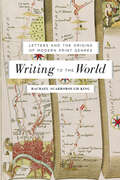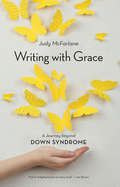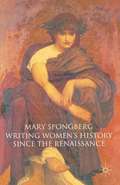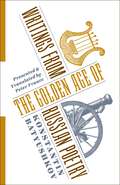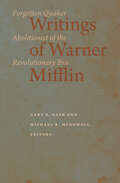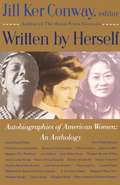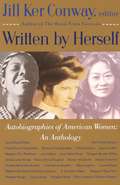- Table View
- List View
Writing the Monarch in Jacobean England
by Jane RickardKing James VI and I's extensive publications and the responses they met played a key role in the literary culture of Jacobean England. This book is the first sustained study of how James's subjects commented upon, appropriated and reworked these royal writings. Jane Rickard highlights the vitality of such responses across genres - including poetry, court masque, sermon, polemic and drama - and in the different media of performance, manuscript and print. The book focuses in particular on Jonson, Donne and Shakespeare, arguing that these major authors responded in illuminatingly contrasting ways to James's claims as an author-king, made especially creative uses of the opportunities that his publications afforded and helped to inspire some of what the King in turn wrote. Their literary responses reveal that royal writing enabled a significant reimagining of the relationship between ruler and ruled. This volume will interest researchers and advanced students of Renaissance literature and history.
Writing the Okanagan
by George BoweringGeorge Bowering was born in Penticton, where his great-grandfather Willis Brinson lived, and Bowering has never been all that far from the Okanagan Valley in his heart and imagination. Early in the twenty-first century, he was made a permanent citizen of Oliver. Bowering has family up and down the Valley, and he goes there as often as he can. He has been asked during his many visits to Okanagan bookstores over the years to publish a collection of his writing about the Valley.Writing the Okanagan draws on forty books Bowering has published since 1960 - poetry, fiction, history, and some forms he may have invented. Selections from Delsing (1961) and Sticks & Stones (1962) are here, as is "Driving to Kelowna" from The Silver Wire (1966). Other Okanagan towns, among them Rock Creek, Peachland, Vernon, Kamloops, Princeton, and Osoyoos, inspire selections from work published through the 1970s and on to 2013. Fairview, the old mining site near Oliver, is the focus of an excerpt from Caprice (1987, 2010), one volume in Bowering's trilogy of historical novels. "Desert Elm" takes as its two main subjects the Okanagan Valley and his father, who, as Bowering did, grew up there. With the addition of some previously unpublished works, the reader will find the wonder of the Okanagan here, in both prose and poetry.
Writing the Stalin Era
by Golfo Alexopoulos Julie Hessler Kiril TomoffCovering topics such as the Soviet monopoly over information and communication, violence in the gulags, and gender relations after World War II, this festschrift volume highlights the work and legacy of Sheila Fitzpatrick offers a cross-section of some of the best work being done on a critical period of Russia and the Soviet Union.
Writing the Story of Texas
by Patrick L. Cox Kenneth E. Hendrickson Jr.The history of the Lone Star state is a narrative dominated by larger-than-life personalities and often-contentious legends, presenting interesting challenges for historians. Perhaps for this reason, Texas has produced a cadre of revered historians who have had a significant impact on the preservation (some would argue creation) of our state's past. An anthology of biographical essays, Writing the Story of Texas pays tribute to the scholars who shaped our understanding of Texas's past and, ultimately, the Texan identity. Edited by esteemed historians Patrick Cox and Kenneth Hendrickson, this collection includes insightful, cross-generational examinations of pivotal individuals who interpreted our history. On these pages, the contributors chart the progression from Eugene C. Barker's groundbreaking research to his public confrontations with Texas political leaders and his fellow historians. They look at Walter Prescott Webb's fundamental, innovative vision as a promoter of the past and Ruthe Winegarten's efforts to shine the spotlight on minorities and women who made history across the state. Other essayists explore Llerena Friend delving into an ambitious study of Sam Houston, Charles Ramsdell courageously addressing delicate issues such as racism and launching his controversial examination of Reconstruction in Texas, Robert Cotner-an Ohio-born product of the Ivy League-bringing a fresh perspective to the field, and Robert Maxwell engaged in early work in environmental history.
Writing the War
by Anne Kiley Thomas Pellechia David KileyAs expansive as it is personal, this chronicle of World War II is a firsthand account by a journalist and the woman he would marry of the dramatic events that engulfed the world in the middle of the twentieth century. The correspondence between Charles Kiley and Billee Gray also tells the poignant tale of two young people in love but forced apart by the circumstances of war. Edited by Charles and Billee's daughter, son, and son-in-law, this never-before-published compilation of letters is a striking example of the heroic, call-to-duty spirit that characterized "the greatest generation. " Charles was a soldier-journalist for the U. S. Army's Stars and Stripes newspaper and reported on the war from London, Normandy, Paris, Reims, Belgium, and Germany. As the sole reporter allowed direct access to Eisenhower's staff, he was the only reporter on the scene when the German high command was negotiating its unconditional surrender on May 7, 1945. Among his army newspaper friends and colleagues was Andy Rooney, later CBS correspondent and 60 Minutes commentator. Billee, like many young women of her time, witnessed the war years from the home front and filled vital civilian roles-defense-industry plant worker, Red Cross volunteer, war bonds salesgirl, and civil defense plane-spotter-and wrote about it all in her letters to Charles. Peppered with fascinating details about soldiers' and civilians' lives, and including Stars and Stripes articles and personal photographs of the era, Writing the War is both important history and a tribute to two remarkable people as well as their extraordinary generation.
Writing Themselves into History: Emily and Matilda Bancroft in Journals and Letters
by Kim BancroftA window into the world of nineteenth-century California, from two women who experienced it firsthand In the early years of California’s statehood, Emily Brist Ketchum Bancroft (1834–1869) and Matilda Coley Griffing Bancroft (1848–1910) had front-row seats to the unfolding of the Golden State’s history. The first and second wives of historian extraordinaire Hubert Howe Bancroft, these two women were deeply engaged members of society and perceptive chroniclers of their times, and they left behind extensive records of their lives and work. Writing Themselves into History offers a rich immersion in nineteenth-century California, detailing Emily’s and Matilda’s experiences with public life, motherhood, and business against the backdrop of San Francisco’s high society and the state’s growth amidst the tumult of the American Civil War. The book also highlights Matilda’s significant involvement in Hubert Howe’s trailblazing research on the history of the American West—including her work collecting oral histories from women members of the LDS Church—and her evocative descriptions of travels throughout the Pacific Northwest and beyond. Kim Bancroft’s commentary offers historical context and points up Emily’s and Matilda’s keen insights, and she pays special attention to the two women’s complex and nuanced portraits of gender, race, and class in the nineteenth-century West. This book is a valuable resource for American West and women’s studies scholars, and for anyone with an interest in California’s first decades as a state.
Writing to Save a Life: The Louis Till File (Canons #84)
by John Edgar WidemanAn award-winning writer traces the life of the father of iconic Civil Rights martyr Emmett Till--a man who was executed by the Army ten years before Emmett's murder. An evocative and personal exploration of individual and collective memory in America by one of the most formidable Black intellectuals of our time.In 1955, Emmett Till, aged fourteen, traveled from his home in Chicago to visit family in Mississippi. Several weeks later he returned, dead; allegedly he whistled at a white woman. His mother, Mamie, wanted the world to see what had been done to her son. She chose to leave his casket open. Images of her brutalized boy were published widely. While Emmett's story is known, there's a dark side note that's rarely mentioned. Ten years earlier, Emmett's father was executed by the Army for rape and murder. In Writing to Save a Life, John Edgar Wideman searches for Louis Till, a silent victim of American injustice. Wideman's personal interaction with the story began when he learned of Emmett's murder in 1955; Wideman was also fourteen years old. After reading decades later about Louis's execution, he couldn't escape the twin tragedies of father and son, and tells their stories together for the first time. Author of the award-winning Brothers and Keepers, Wideman brings extraordinary insight and a haunting intimacy to this devastating story. An amalgam of research, memoir, and imagination, Writing to Save a Life is completely original in its delivery--an engaging and enlightening conversation between generations, the living and the dead, fathers and sons. Wideman turns seventy-five this year, and he brings the force of his substantial intellect and experience to this beautiful, stirring book, his first nonfiction in fifteen years.
Writing to the World: Letters and the Origins of Modern Print Genres
by Rachael Scarborough KingLetters played a foundational role in facilitating the rise of print and popularizing new modes of writing in the long eighteenth century.In Writing to the World, Rachael Scarborough King examines the shift from manuscript to print media culture in the long eighteenth century. She introduces the concept of the "bridge genre," which enables such change by transferring existing textual conventions to emerging modes of composition and circulation. She draws on this concept to reveal how four crucial genres that emerged during this time—the newspaper, the periodical, the novel, and the biography—were united by their reliance on letters to accustom readers to these new forms of print media.King explains that as newspapers, scientific journals, book reviews, and other new genres began to circulate widely, much of their form and content was borrowed from letters, allowing for easier access to these unfamiliar modes of printing and reading texts. Arguing that bridge genres encouraged people to see themselves as connected by networks of communication—as members of what they called "the world" of writing—King combines techniques of genre theory with archival research and literary interpretation, analyzing canonical works such as Addison and Steele’s Spectator, Samuel Johnson’s Lives of the Poets, and Jane Austen’s Northanger Abbey alongside anonymous periodicals and the letters of middle-class housewives. This original and groundbreaking work in media and literary history offers a model for the process of genre formation. Ultimately, Writing to the World is a sophisticated look at the intersection of print and the public sphere.
Writing to the World: Letters and the Origins of Modern Print Genres
by Rachael Scarborough King“King’s pitch for the indebtedness of the genres we know well—the novel, the biography, the magazine piece—to letter writing is stylish and convincing.” —Christina Lupton, author of Reading and the Making of Time in the Eighteenth CenturyIn Writing to the World, Rachael Scarborough King examines the shift from manuscript to print media culture in the long eighteenth century. She introduces the concept of the “bridge genre,” which enables such change by transferring existing textual conventions to emerging modes of composition and circulation. She draws on this concept to reveal how four crucial genres that emerged during this time—the newspaper, the periodical, the novel, and the biography—were united by their reliance on letters to accustom readers to these new forms of print media.King explains that as newspapers, scientific journals, book reviews, and other new genres began to circulate widely, much of their form and content was borrowed from letters, allowing for easier access to these unfamiliar modes of printing and reading texts. Arguing that bridge genres encouraged people to see themselves as connected by networks of communication—as members of what they called “the world” of writing—King combines techniques of genre theory with archival research and literary interpretation, analyzing canonical works such as Addison and Steele’s Spectator, Samuel Johnson’s Lives of the Poets, and Jane Austen’s Northanger Abbey alongside anonymous periodicals and the letters of middle-class housewives.This original and groundbreaking work in media and literary history offers a model for the process of genre formation. Ultimately, Writing to the World is a sophisticated look at the intersection of print and the public sphere.“This erudite, sophisticated, beautifully written book is a major achievement.” —Thomas Keymer, author of Poetics of the Pillory
Writing with Grace
by Judy McfarlaneWhen Judy McFarlane is asked if she will help Grace, a woman with Down syndrome who dreams of becoming a famous writer, she realizes she holds deep, unacknowledged fears - that Grace will be a dull-eyed young woman who can't read, let alone write, or that she might become agitated, even lash out. But the idea that Grace wants to be a writer, a dream McFarlane gave up when she was young, captures McFarlane. She helps Grace write her book and travels with Grace to give a copy of the book to her grandfather. Writing with Grace is the inspiring and informative story of the journey Grace and Judy have taken together. It relates the often-dark history of Down syndrome and tells a universal story of moving from a deep fear of the "other" to seeing the world through the eyes of another person. With honest introspection and keen insight, Writing with Grace delves into what it takes to face one's own prejudice and what it means to live a full life and believe you are worthy.
Writing Women’s History since the Renaissance
by Mary SpongbergThe complaint of Catherine Morland in Jane Austen's Northanger Abbey, that history has 'hardly any women at all' is not an uncommon one. Yet there is evidence to suggest that women have engaged in historical writing since ancient times. This study traces the history of women's historical writing, reclaiming the lives of individual women historians, recovering women's historical writings from the past and focusing on how gender has shaped the genre of history. Mary Spongberg brings together for the first time an extensive survey of the progress of women's historical writing from the Renaissance to the present, demonstrating the continuities between women's historical writings in the past and the development of a distinctly woman-centred historiography. Writing Women's History since the Renaissance also examines the relationship between women's history and the development of feminist consciousness, suggesting that the study of history has alerted women to their unequal status and enabled them to use history to achieve women's rights. Whether feminist or anti-feminist, women who have had their historical writings published have served as role models for women seeking a voice in the public sphere and have been instrumental in encouraging the growth of a feminist discourse.
Writings from the Golden Age of Russian Poetry (Russian Library)
by Konstantin BatyushkovKonstantin Batyushkov was one of the great poets of the Golden Age of Russian literature in the early nineteenth century. His verses, famous for their musicality, earned him the admiration of Alexander Pushkin and generations of Russian poets to come. In Writings from the Golden Age of Russian Poetry, Peter France interweaves Batyushkov’s life and writings, presenting masterful new translations of his work with the compelling story of Batyushkov’s career as a soldier, diplomat, and poet and his tragic decline into mental illness at the age of thirty-four. Little known among non-Russian readers, Batyushkov left a varied body of writing, both in verse and in prose, as well as memorable letters to friends. France nests a substantial selection of his sprightly epistles on love, friendship, and social life, his often tragic elegies, and extracts from his essays and letters within episodes of his remarkable life—particularly appropriate for a poet whose motto was “write as you live, and live as you write.” Batyushkov’s writing reflects the transition from the urbane sociability of the Enlightenment to the rebellious sensibility of Pushkin and Lermontov; it spans the Napoleonic Wars and the rapid social and literary change from Catherine the Great to Nicholas I. Presenting Batyushkov’s poetry of feeling and wit alongside his troubled life, Writings from the Golden Age of Russian Poetry makes his verse accessible to English-speaking readers in a necessary exploration of this transitional moment for Russian literature.
Writings of Warner Mifflin: Forgotten Quaker Abolitionist of the Revolutionary Era
by Warner MifflinIn The Writings of Warner Mifflin: Forgotten Quaker Abolitionist of the Revolutionary Era Gary B. Nash and Michael R. McDowell present the correspondence, petitions and memorials to state and federal legislative bodies, semi-autobiographical essays, and other materials of the key figure in the U.S. abolitionist movement between the end of the American Revolution and the Jefferson presidency. Virtually unknown to Americans—schoolbooks ignore him, academic historians barely nod at him; the public knows him not at all--Mifflin has been brought to life in Gary B. Nash’s recent biography, Warner Mifflin: Unflinching Quaker Abolitionist (2017). This volume provides an array of insights into the mind of a conscience-bound pacifist Quaker who became instrumental in making Kent County, Delaware a bastion of free blacks liberated from slavery and a seedbed of a reparationist doctrine that insisted that enslavers owed “restitution” to manumitted Africans and their descendants. Mifflin's writings also show how he became the most skilled lobbyist of the antislavery campaigners who haunted the legislative chambers of North Carolina, Virginia, Maryland, Delaware, and Pennsylvania as well as the halls of the Continental Congress and the First and Second Federal Congresses. An opening introduction and introductions to each of the five chronologically arranged parts of the book provide context for the documents and a narrative of the life of this remarkable American.
Written by Herself: Volume I
by Jill Ker ConwayThe bestselling author of The Road from Coorain presents an extraordinarily powerful anthology of the autobiographical writings of 25 women, literary predecessors and contemporaries that include Jane Addams, Zora Neale Hurst, Harriet Jacobs, Ellen Glasgow, Maya Angelou, Sara Josephine Baker, Margaret Mead, Gloria Steinem, and Maxine Hong Kingston.From the Trade Paperback edition.
Written by Herself: An Anthology
by Jill Ker ConwayAn extraordinarily powerful anthology of the autobiographical writings of 25 women, literary predecessors and contemporaries that include Jane Addams, Zora Neale Hurston, Harriet Jacobs, Ellen Glasgow, Maya Angelou, Sara Josephine Baker, Margaret Mead, Gloria Steinem, and Maxine Hong Kingston.
Written By Herself, Volume II: Women's Memoirs from Britain, Africa, Asia, and the United States
by Jill Ker ConwayThe bestselling author of The Road from Coorain presents an extraordinarily powerful anthology of the autobiographical writings of 25 women, literary predecessors and contemporaries that include Jane Addams, Zora Neale Hurst, Harriet Jacobs, Ellen Glasgow, Maya Angelou, Sara Josephine Baker, Margaret Mead, Gloria Steinem, and Maxine Hong Kingston.

